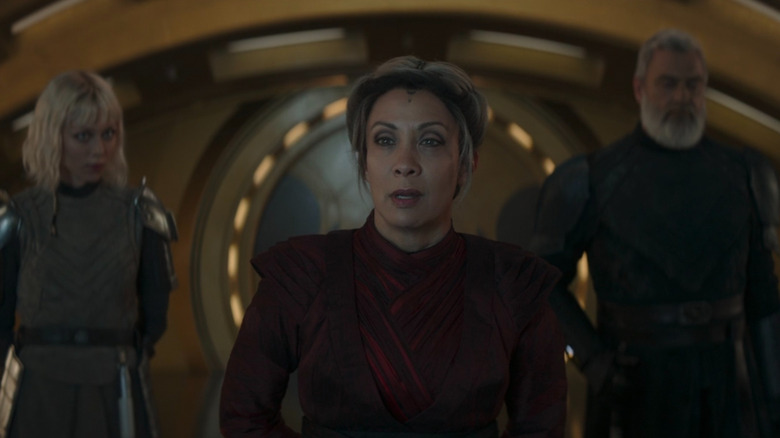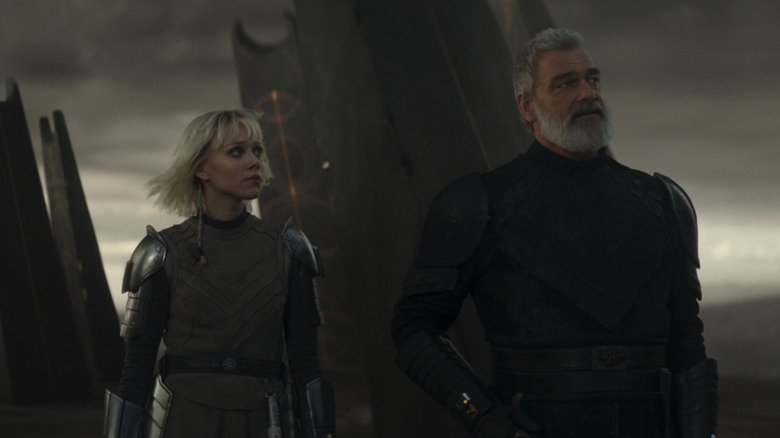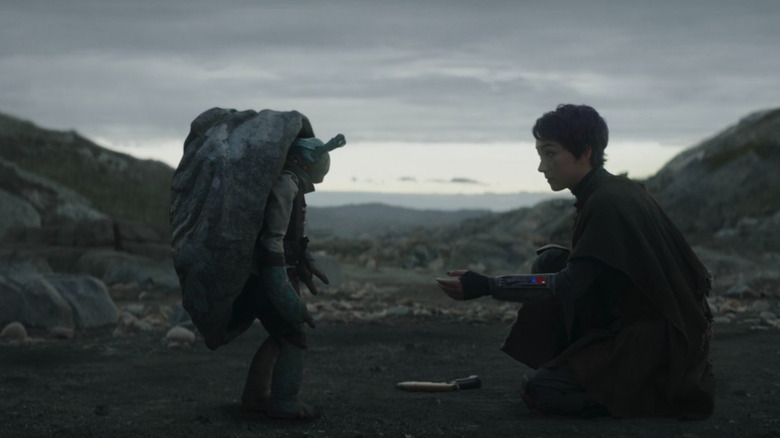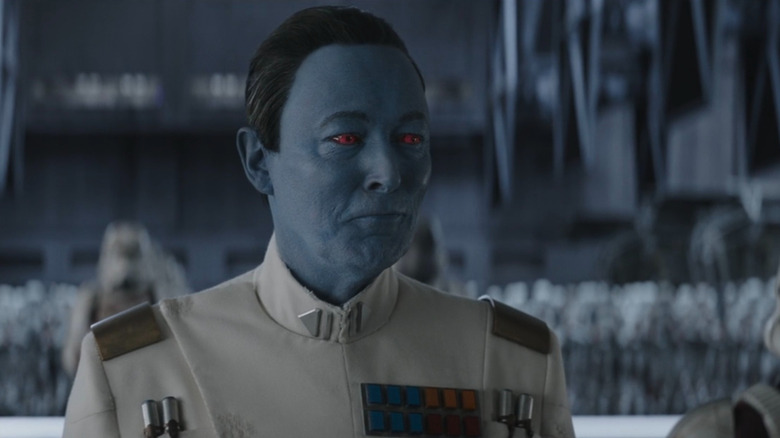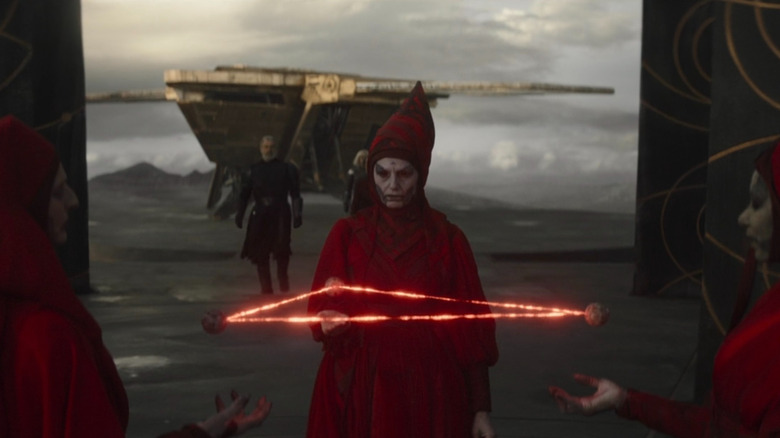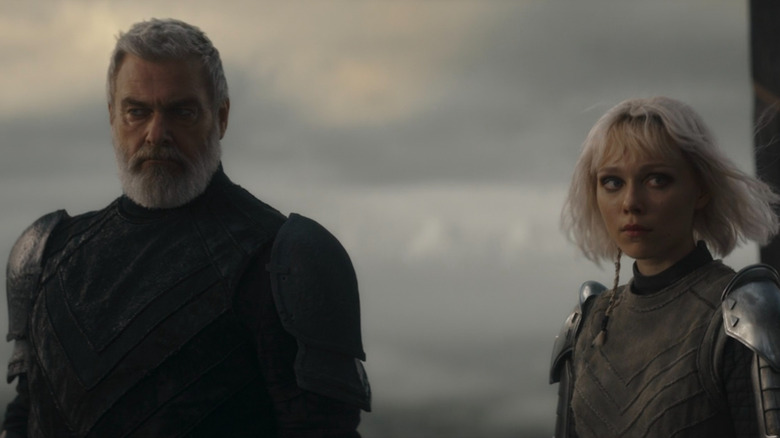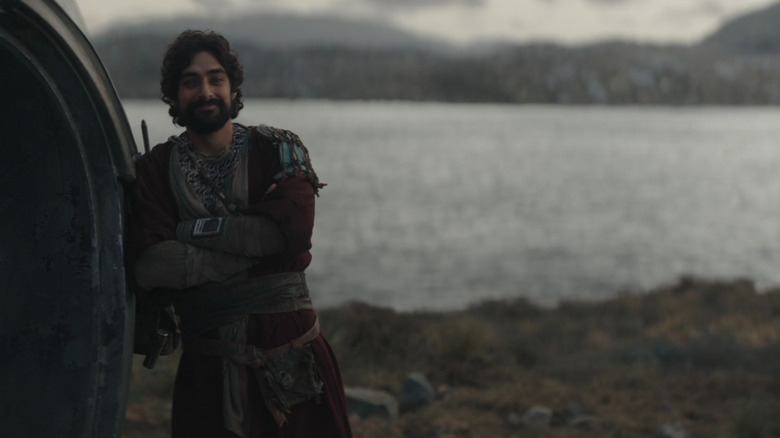Ahsoka Delivers A Tremendous Set Up For The Series' Final Conflict In 'Far, Far Away'
This article contains spoilers for "Star Wars: Ahsoka" episode 6 — "Far, Far Away"
In this episode of "Ahsoka," the Eye of Scion makes its way to Peridea, the fabled homeland of Witches of Dathomir and the graveyard of the purrgil an entire galaxy away. The Great Mother, a witch of Dathomir, greets Morgan Elsbeth (Diana Lee Inosanto), Baylan Skoll (Ray Stevenson), Shin Hati (Ivanna Sakhno), and Sabine Wren (Natasha Liu Bordizzo). They were sending dreams and messages to Morgan Elsbeth to help her find her way to this planet and rescue Thrawn from his exile. Grand Admiral Thrawn arrives with great pomp aboard his Star Destroyer, the Chimera. As per his deal with the witches, he is transferring cargo for them and this will take three days. In the meantime, Thrawn is willing to honor Baylan Skoll's agreement with Sabine Wren and gives her what she needs to search for Ezra in the wasteland of Peridea. Thrawn goes about his preparations while Sabine seeks out Ezra, but Baylan Skoll and Shin Hati hunt her down. As is revealed, their bargain ends when she finds Ezra, and then all bets are off. Ultimately, with the help of the adorable rock-insect people the Noti, Sabine finds Ezra but declines to tell him how dire their situation is.
Meanwhile, the Nightsisters reveal to Thrawn that a new Jedi approaches riding in a purrgil, and he makes preparations to destroy her if she were to interfere with his plans. For a show about Ahsoka Tano, this episode doesn't feature very much of the titular character.
Baylan's true desire
One of the most interesting ideas in this episode comes from Baylan Skoll. He's been one of the most interesting characters on this show from the get-go, even though he hasn't had a chance to really delve into his backstory. This episode finally gave him a chance to shine and talk more about his motivations, and it feels like he's actually got the same idea as Luke Skywalker in "The Last Jedi," but is going about it in the exact opposite fashion. Baylan has embraced the dark to find a power strong enough to end the cycles of conflict in the galaxy in Thrawn because, as a student of history, he sees that the Sith and the Jedi, light and dark, come back and inevitably wipe each other out.
Where Luke tries to break the cycle of violence by throwing away his lightsaber, exiling himself on Ahch-to, and cutting himself off from the Force so he can't sense the future, Baylan Skoll embraces a darker, larger view of the Force and his place in it. It's a fascinating connection to Luke Skywalker in the sequel trilogy and shades Luke's motivations there and how he goes about it in a fascinating way. Watching the dark opposite to something we've seen the light side version of is something Dave Filoni has brought us before, for example, the training of Savage Opress by Count Dooku as a dark inversion of Luke's Jedi training on Dagobah. This altruism to Baylan makes him all the more sympathetic, even though he is going about things entirely the wrong way.
And what is the power he senses greater than even Thrawn? I think that line could pass by most viewers, but I really think that's the key to whatever the end of this season of this show will be. Will it be as large and impactful as the Bendu was on Thrawn's defeat on Atollan in "Star Wars Rebels"? We will have to wait and see.
Dare to be cute
A common refrain from George Lucas during the making of "Return of the Jedi" that got quoted in a 1983 issue of Rolling Stone was "dare to be cute." This is what yielded him the Ewoks as the saviors of the fight against the Empire. It's no wonder his protege, Dave Filoni, would take a page out of that book, especially with a character like Ezra and a show like this.
As Sabine searches for Ezra, she comes in contact with an adorable insectoid race with rocks on their back called the Noti. She communicates with them much like Princess Leia speaks to Wicket W. Warrick in "Return of the Jedi" and they're the ones who end up leading her to Ezra. There's a great theme in "Star Wars" that being nice to the lesser beings brings you a greater goal and it's a function of fairy tales ancient and recent alike. It's central to Jar Jar Bink's story, as well as the Ewoks. George Lucas explained it to Mark Hamill and Richard Marquand in the behind-the-scenes documentary "From Star Wars to Jedi," saying ,"In a fairytale, it's always being nice to the little bunny rabbit on the side of the road that gives you the magic that makes you go and rescue the princess from the evil witch."
That's exactly what we have with the Noti (as well as the adorable Howler mount Sabine rides) and this idea is a central part of "Star Wars" from its very beginning. I wouldn't hesitate to guess they'll play an even larger part in the story during the final two episodes of this season.
Thrawn's lessons learned
However, the Grand Admiral Thrawn we see in this episode is not the same Thrawn who was thwarted in "Star Wars Rebels." In "Rebels," his great weakness is his inability to perceive the workings of the Force. At the previously mentioned Battle of Atollon, which is the end of the third season, he is thwarted by the outrage of the Bendu — a massive creature of the Force voiced by Tom Baker of "Doctor Who." He's able to predict the human element, but the mystical workings of the Force are beyond him. He learns from that to an extent when he travels to Lothal to finally end the threat of Ezra Bridger's band of Rebels. Yet, once again, he underestimates the machinations of the Force and Ezra is able to outmaneuver him and take him off the map using the purrgils, a move literally no one without the ability to see the future could have predicted. As Thrawn is now in league with the Witches of Dathomir on Peridea, using their divinations to revise his strategies, he's going to be much more difficult to beat since he is working to shore up his shortcomings from before.
And with the Nightsisters packing up an entire three days' worth of catacombs and their ability to raise the dead into zombie armies, Thrawn could be plotting something huge with their resources that could change the galaxy forever.
Details to watch out for
There were a few fascinating things to notice in this episode. The first was the first use of the phrase "A long time ago, in a galaxy far, far away," in the actual universe itself. George Lucas always said that was his way of saying, "Once upon a time in a land far away," and it's fitting that Huyang (David Tenant) begins his story there in the pre-title credit scene. This whole episode is filled with fairy tales. Dreams and madness, as Baylan Skoll puts it. And it's thematically resonant with everything we see from there forward.
Reports of the extinction of the Witches of Dathomir appear to be greatly exaggerated as we learn that Peridea is actually their ancient homeworld, and the Great Mother is given the same voice treatment as Mother Talzin from "The Clone Wars." Their being back in the world of "Star Wars" could mean quite a bit in the future if Thrawn is able to utilize them and bring them back to the galaxy.
As Thrawn arrives, we see his signature Star Destroyer the Chimaera, with its stylized image of the "Star Wars" version of a chimaera fish painted on the underside of its hull. That's a detail Timothy Zahn put into Thrawn's myth in his very first appearance in "Heir to the Empire." But there are more interesting things about Thrawn's appearance, namely his stormtroopers. They've spent well over a decade in this exile and they obviously don't have replacement parts, so their masks and armor have been cobbled back together with gold in the Japanese tradition of Kintsugi. This is something we've seen before in "Star Wars" and might be an oblique tie to Kylo Ren, as he repairs his helmet in "The Rise of Skywalker."
Even more details to watch out for
Another interesting callout comes from Baylan Skoll. He refers to Ezra Bridger as a Bokken Jedi, trained in the wild after the destruction of the Temple and the Order. In real life, a bokken is a training sword in the Japanese tradition, but "Star Wars" has adopted that language for the wooden training sabers that Jedi use to train with as well. That implies that Bokken Jedi is a derogatory term ... they're a pretend, fake Jedi practice rather than the real thing.
The last thing I'd point out is the spreading of the spark. In "The Last Jedi," Admiral Holdo calls out the most important mission of the Resistance as spreading the spark of hope across the galaxy. Finn and Rose do exactly that by giving the symbol of the Rebellion and Resistance to the children on Canto Bight. This is the spark that will light the fire across the galaxy. Ezra has done the same thing with the Noti, and this is what enabled them to recognize Sabine as a friend and bring her to Ezra. It's a really wonderful bit of symmetry and a further tie to the best installment of the sequel trilogy.
The final stakes
This episode feels very much like a release and a build-up all at the same time. We've spent six episodes waiting for the return of Thrawn and Ezra and now we finally have them, but there are still so many unanswered questions. For an episode that is essentially table-setting the final conflict, it wins in how much they "dared to be cute." The Howler and the Noti are utterly delightful to watch. But it also wins in the stakes it sets up. Thrawn is one of the great villains of "Star Wars" and he is an immovable object to Ahsoka Tano's unstoppable force.
The unsung hero of these last couple of episodes, too, is Kevin Kiner and his two kids who compose the music for the show. The musical build-up to Thrawn's reveal is nothing short of terrific and I can't wait for the soundtrack for this half of the season to come out.
Directed by Jennifer Getzinger, she brings a charm to an episode that could have easily been nothing but drab and I really respect and admire that. "Star Wars" at its heart is a fairy tale for kids and she was able to — with Filoni's script — bring that to the front of a tremendously important build-up episode.
For those who love the mystical Force aspects of "Star Wars" and for those who love the silly "cute" parts of it, this episode is a feast. For those who would prefer a drab and dour take on "Star Wars" and who think Thrawn is only cool because of his calculating demeanor, they might have a better time watching "Andor," which is terrific, to be sure, but a very different flavor of what "Star Wars" can be.
New episodes of "Ahsoka" premiere on Tuesday nights on Disney+ at 6:00 pm Pacific, 9:00 pm Eastern.
